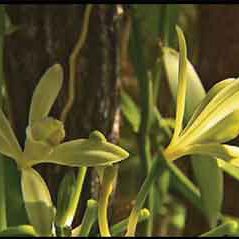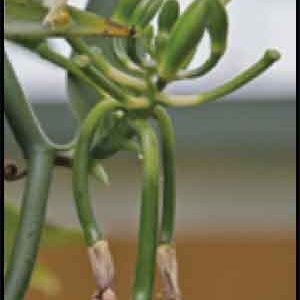Vanilla planifolia
Vanilla
Origin
Southern Mexico, Guatemala and Costa Rica.
Climate
Lowland humid tropical. Vanilla requires a warm, humid climate of 20-30°C with frequent rains and prefers an evenly distributed annual rainfall of 1500-3000 mm. A moderately dry 3 months helps keep fungus down during the ripening of the pods. It can tolerate temperatures down to 5°C for short periods.
Plant Description
Vanilla is a leggy, fleshy, herbaceous vine that can reach about 15m or more. It climbs with the aid of aerial roots produced all along the stem, opposite to leaves. The stem is cylindrical in shape and grows upwards in a zigzag pattern. Leaves are flat, fleshy and have a short petiole. They can be bright green or green and white variegated and their shape varies between elliptical and lanceolate with an acute, rounded tip. The leaves are between 8 and 25cm in length and 2 to 8cm in width. The flowers are large, waxy and fragrant, usually yellow-green. The plants also develop a surface root system which should be protected with a 10cm layer of mulch. Take care not to damage these surface roots and don’t tread on them.
Relatives
It is a member of the large and diverse Orchidaceae family. There are about 110 species in the Vanilla genus.
Soils
It can be grown in various types of soils from sandy loam to laterites. Good drainage, organic matter level of about 2.5%. and a pH of about 7 is desirable. A generous mulch layer, made from many different plant species can provide almost all fertilizer needs.
Propagation
Cuttings must have at least 5 internodes, and if they are to be planted in the field, they will come into fruiting quicker if they have 18 to 24 internodes. Cuttings should be taken from mature vegetative wood, not from wood which has flowered. To plant cuttings: lay them out with several bottom internodes, minus leaves, in a shallow trench, cover with good soil and mulch. Fasten the upper several internodes to a stake or trellis and water well.
Seeds may be used to develop new cultivars but they’re very small and difficult to germinate. The pods contain a germination-inhibiting substance.
Cultivars
There are three major species of vanilla: Vanilla planifolia, sometimes called ‘Bourbon’, represents 95% of the world’s crop, V. tahitensis, and V. pompona. The different species have distinctive flavours.
Flowering and Pollination
Flowering occurs only once a year, but happens over a span of about 2 months. Buds are borne on upright racemes, which open by twos and threes from the bottom upwards. Each flower opens only once, beginning in the very early morning, and closing by mid-morning. The vanilla flower is perfect, but incapable of self-pollination without assistance, either by its special species of bee or by humans.
In some places, the flowers are pollinated by hummingbirds. The natural pollinating insect, a bee, is only present in a small area of Mexico, so all vanilla flowers outside this region must be hand-pollinated. A small slender stick is used to scoop up the pollen and press the flower open to allow the pollen to be placed correctly. A skilled pollinator can pollinate perhaps 1000 flowers per morning, and in a plantation, it must be done every morning during the flowering season.
Unpollinated flowers drop off the next day.
Cultivation
Vanilla requires light dappled shade, provided by sheltering trees or shadecloth. Too much shade is detrimental. The mulch layer on the ground must be maintained with sufficient depth to allow good growth of the terrestrial roots. Plants must be inspected frequently as they try to grow straight up and often need to be fastened to their trellis in order to keep them at a useful level.
Wind Tolerance
Needs windbreaks.
Pruning
Vanilla is a rainforest species which grows upward until it reaches good light; vines can be very long. When a new shoot reaches a length of 2m, it should be ‘looped’. This consists of carefully (the vines are very fragile) detaching the upper part of a long shoot (20-25 nodes) from the support. The vine has to be bent over the support at an appropriate height so that the extremity of the stem is placed near the soil. Leaves near the soil must be removed to prevent fungal attack, and the upper part of the vine is attached to the support. The shoots should be placed so that the upper leaf surfaces are orientated towards the sunlight. Looping is an important operation because it allows formation of new roots and shoots, and therefore good growth.
Pruning is done to eliminate thin or weak stems and to encourage lateral growth. Only vigorous, healthy vines should be allowed to bear fruit. On plants large enough to begin bearing, the stem top can be removed six month before flowering, to increase the number of inflorescences. After pods are harvested, cut the spent stem back to a growth bud on the main stem.
The Fruit
The fruit is a capsule, the seed pod of the plant. It is often called a ‘bean’. The seed pods grow in clusters or racemes and individual pods are usually about 10 to 25cm long, rather triangular in cross-section. Only the flowers that hang down should be pollinated: don’t allow the vine to make excessive pods as the quality of all will deteriorate. The green pods have no vanilla scent or flavour: they must be cured for the scent and flavour to develop.
Fruit Production and Harvesting
The vanilla vines begin to produce fruit only when mature in the second or third year and are at least 3m long. The pods take about 5 to 9 months from pollination to maturity. When the tips of the green pods begin to turn yellow, they are picked. Again, ripening occurs over a span of time, so picking will be staggered.
The pods then undergo a lengthy processing system. They are sorted by size and condition and plunged into vats of hot water (63°C). This is called ‘killing’ and is an essential step in the curing process. Then they are drained, wrapped in darkcoloured cotton fabric and dried on slatted platforms with sun exposure for an hour or two every day until they become flexible. They are then spread on racks in shade or ventilated rooms for 2 or 3 months. They are finished when their fragrance and flavour have developed and they become the familiar fragrant dark brown sticks.
Fruit Uses
Vanilla is one of the world’s most popular flavourings and the second-most expensive flavouring, after saffron. Alcohol-based vanilla extract is readily available (imitation vanilla-flavoured extract is even more common). To use a dried vanilla bean, split it and scrape out the seeds which can then be mixed into any liquid. The remainder of the bean can be stored in a jar of sugar which absorbs the flavour. You can make your own vanilla extract by immersing a bean in a jar of unflavoured vodka for a few weeks.
Pests and Diseases
Not many insects bother vanilla. Fungal diseases are more of a problem. Environmental conditions favouring diseases are excessive moisture, prolonged rainy weather, insufficient drainage, too much shade, damage to roots and over-planting of vanilla. Fungal diseases like shoot tip rot, stem and bean rot caused by Phytophthora sp. as well as immature bean dropping are sometimes noticed. Fusarium oxysporum causes another kind of stem rot. Incidence of diseases can be reduced by maintaining conditions leading to vigorous growth of vines such as adequate shade, heavy mulch especially during the dry season, moderate to light pollination, irrigation during extended dry periods, application of fertilizers and providing adequate drainage. Over-crowding of vines on a single support also should be avoided. Keep an eye out for snails.
Comments
The ABC made a Landline program on research into growing and processing vanilla. The main message was that vanilla can be grown in greenhouses in the same conditions as tomatoes, and research done in a University of Western Sydney lab has brought the processing time down to 3 weeks by carefully controlling all the conditions such as temperature and humidity.

